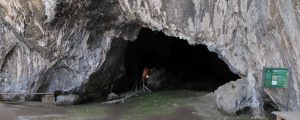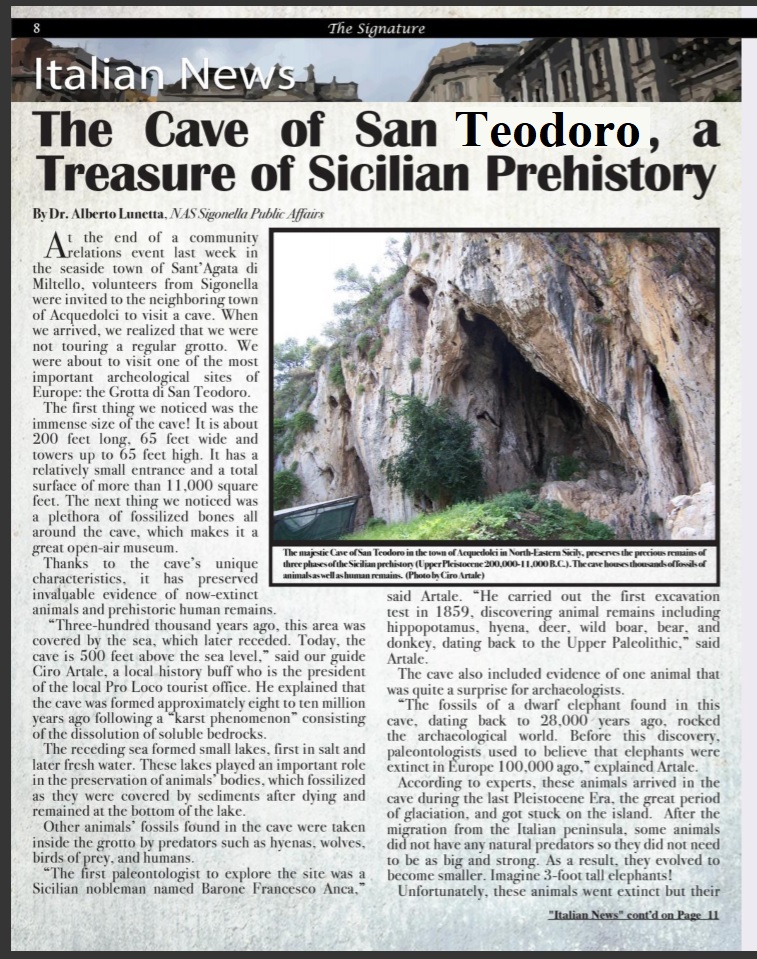Italian version
The Pizzo Castellaro – northern offshoot of the towering San Fratello Mount – rises about two kilometers south-east of the town of Acquedolci, in an area enriched by citrus groves and centuries-old olive trees. Its rocky wall houses the cave of San Teodoro, at 140 meters above sea level.

The cave was formed following a karst phenomenon that occurred approximately eight to ten million years ago, and preserves a very rich and very important documentation of the history of Sicily in terms of animals population – now extinct – and of prehistoric man remains.
The first mention of the cave of San Teodoro and the paleontological and paleoethological deposits located inside it and on the talus in front of it, is due to Baron Anca’s exploration, who carried out a first excavation test in 1859. He noticed the cave housed deposits from the Upper Paleolithic, and in the large essay he made at the entrance to the cave he found a sediment that contained animal remains (dwarf elephant, hyena, deer, wild boar, bear, donkey).
Subsequent investigations, each of extraordinary importance, are due to Vaufray (1925), Graziosi and Maviglia (1942), and Bonfiglio (1982-1985, 1987, 1989, 1992, 1995, 1998, 2002, 2004).
The Cave of San Teodoro was inhabited by man within a period of time which is approximately estimated between 12,000 and 8,000 years BC; from a cultural point of view, it represents the last period of the Italian Upper Paleolithic, commonly called the Final Epigravettian.
The uniqueness and importance of the cave is due to the discovery of the first Sicilian Paleolithic burials: there are five skulls and two exceptionally complete skeletons that were the first to allow a thorough knowledge of the ancient inhabitants of Sicily. The burials’ ritual consisted in the deposition of the deceased in a shallow grave in a supine position or on their left side, surrounded by animal bones, pebbles and ornaments composed by necklaces made with deer teeth. All the burials were covered with a light layer of earth and ocher (natural dye) was scattered over it.
The most important evidence was the discovery of the fossil remains of a woman of about 30 years old and 165 cm tall, who was given the name of Thea (from Latin Theodora) to connect it to that of the cave.


THE LITHIC INDUSTRY
The deposit of the cave was composed of a stratigraphy of overlapping land in which the remains of human presence are preserved. Hearths, animal bones belonging mostly to the remains of food, and abundant lithic industry belonging to a final phase of the so-called Epigravettian horizon of the Upper Paleolithic (about 12000-8000 years BC) were found.
The lithic industry of San Teodoro is made up of different tools that man used in hunting and in work activities such as leather processing and food preparation. It was built with rocks that are collected in the territory, quartzite and flint. Flint tools are often small in size (microliths) with scratchers, back and geometric tips, while those in quartzite have larger dimensions and there are burins, scratchers, scraper blades and back tips. The abundance of lithic industry shows that the processing, that is the chipping of the flint and quartzite, took place both inside and outside the cave.
The rich presence of geometrics (very small instruments in the shape of triangles) has made this industry considered as a regional facies, typical of Sicily, so much so that it is called “San Teodoro’s facies”.
Animal remains indicate the presence of deer, prehistoric ox, and wild boar, while the study of the coals has provided data on that period’s environment around the cave, which must have been formed by an oak and maple trees forest.
Inside the cave – below the layers with the evidence of the Paleolithic – the deeper sediments contain skeletal remains of vertebrates (hyena, wolf, fox, wild boar, prehistoric ox, endemic elephant, endemic deer, small horse) and of hyena’s coprolites; this relates to a period (upper Pleistocene, about 125,000-35,000) in which the cave was frequented by populations of hyenas who over time have transported fragments of the predated animals’ carcasses. The hyenas’ den (crocuta crocuta spelaea) has been dated from the Bonfiglio excavations (1998, 2002) to the end of the Upper Pleistocene (about 35,000 years from now).
Inside the cave, but mainly outside, numerous ceramic pottery fragments from various eras identifies the presence of prehistoric human groups from the Bronze Age; they also identify frequentations which also occurred during the Greek and Roman period up to modern times. These documents offer other notable possibilities to broaden the archaeological knowledge on the territory of Acquedolci.
Outside the cave: the lake basin and the HIPPOS DEPOSIT
A paleontological deposit containing numerous fossil remains of Hippopotamus pentlandi extends in front of the high limestone wall which houses San Teodoro cave and other caves such as Riparo Maria.
The deposit is the remnant of an ancient lake basin existing during the Middle Pleistocene (700,000-125,000 years from now).
The fossil remains of the Acquedolci’s hippopotamus date back to the end of the Middle Pleistocene, that is to an age of about 200,000 years. These fossils – despite the intense crushing suffered – represent an important contribution to the morphological and phylogenetic study of the Pleistocene hippopotamus of Sicily.
In Acquedolci the existence of a lake basin has allowed the life of populations of hippos whose skeletal remains – buried in the sediments at the bottom of the basin – have been preserved by the thousands; for this reason the deposit offers an abundance of remains such as to allow a detailed study of the hippos and to recognize the other mammals species present.


We would like to thank Dr. Maria Clara Martinelli for her useful suggestions for drafting the final text.
____________________________
About: Museo Gemmellaro
Download the brochure:
“La grotta di San Teodoro e gli ippopotami di Acquedolci” (1992)
Download the booklet:
“I tesori della preistoria siciliana ad Acquedolci e alla Grotta di San Teodoro” (2005)
Download the brochure created by the Ente Parco dei Nebrodi:
“Grotta di San Teodoro” (2019)
VIDEO
- “La grotta di San Teodoro: dalla scoperta a Thea madre.“
- “Linea Blu” RAI UNO
Mediterraneo 2050 – La Grotta di San Teodoro
(from the minute 58 and 35 second) – 2 july 2018 - Il Ponte sullo Sterrto esisteva già 20.000 anni fa – Video Calabria (2004)
- “Sicilia protetta” on Mediaset Play
Il Parco dei Nebrodi e la Grotta di San Teodoro

Photos of the cave – Promotion days of 2019
____________________________
ARCHAEOLOGICAL AREA CAVE OF SAN TEODORO – Ticket: Free

Location: Contrada Favara – mobile 338 7837409
Entrance times:
Every day including holidays (winter: 9.00 to 13.00)
April to September: 9.00 to 19.00
October to March: 9.00 to 15.30
_________________________________________

MUNICIPAL ANTIQUARIUM
square Giovanni Paolo II
Opening hours:
Monday to Friday, from 9.00 a.m. to 1.00 p.m.
Tuesday and Thursday from 15.30 to 17.30
Ticket: Free *
_________________________________________
* School schools, tour operators, bodies, associations and organized visits can request the opening of the premises on days and dates other than those established upon request or communication to be forwarded to the Municipality at least 15 days before the scheduled date.


